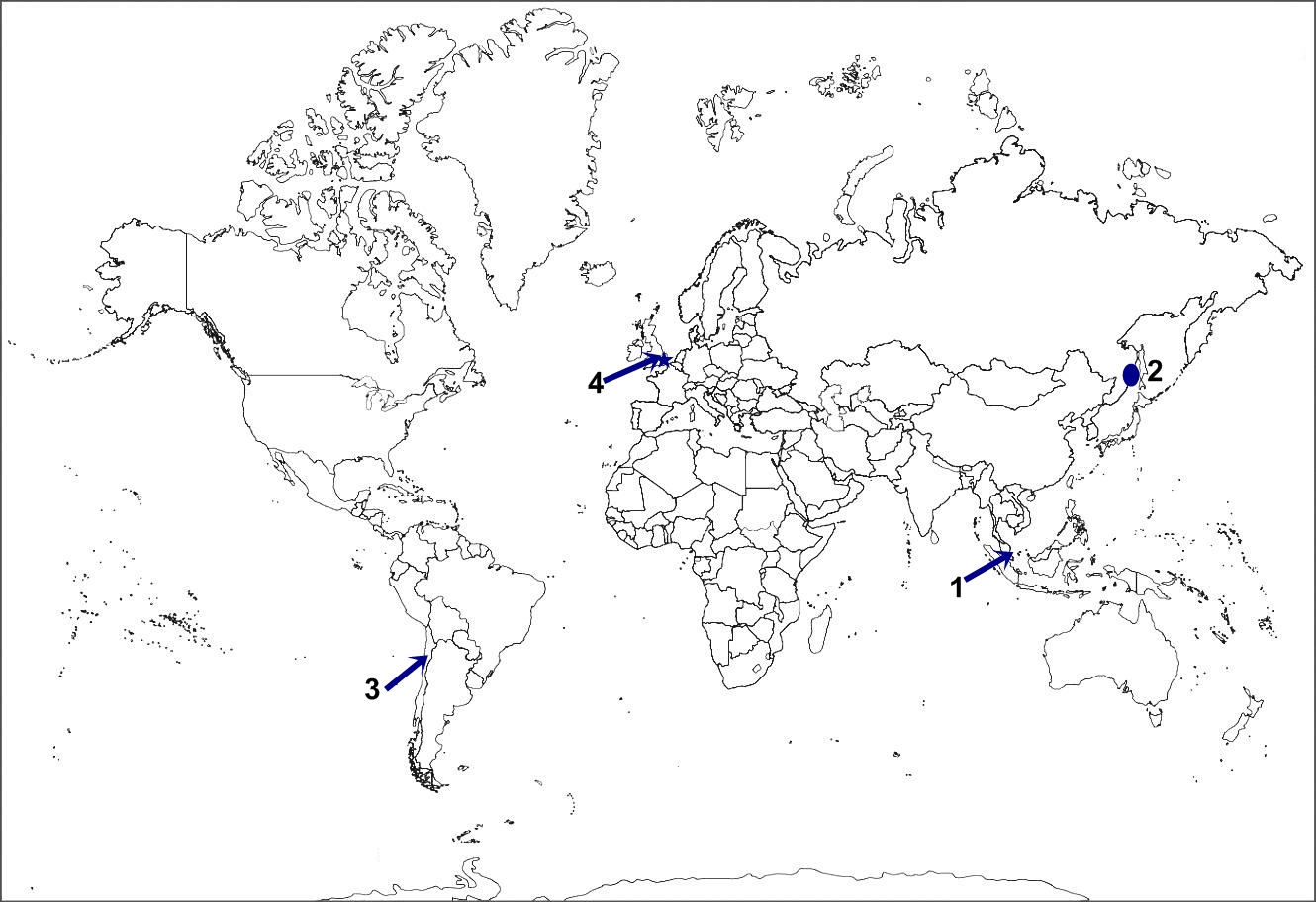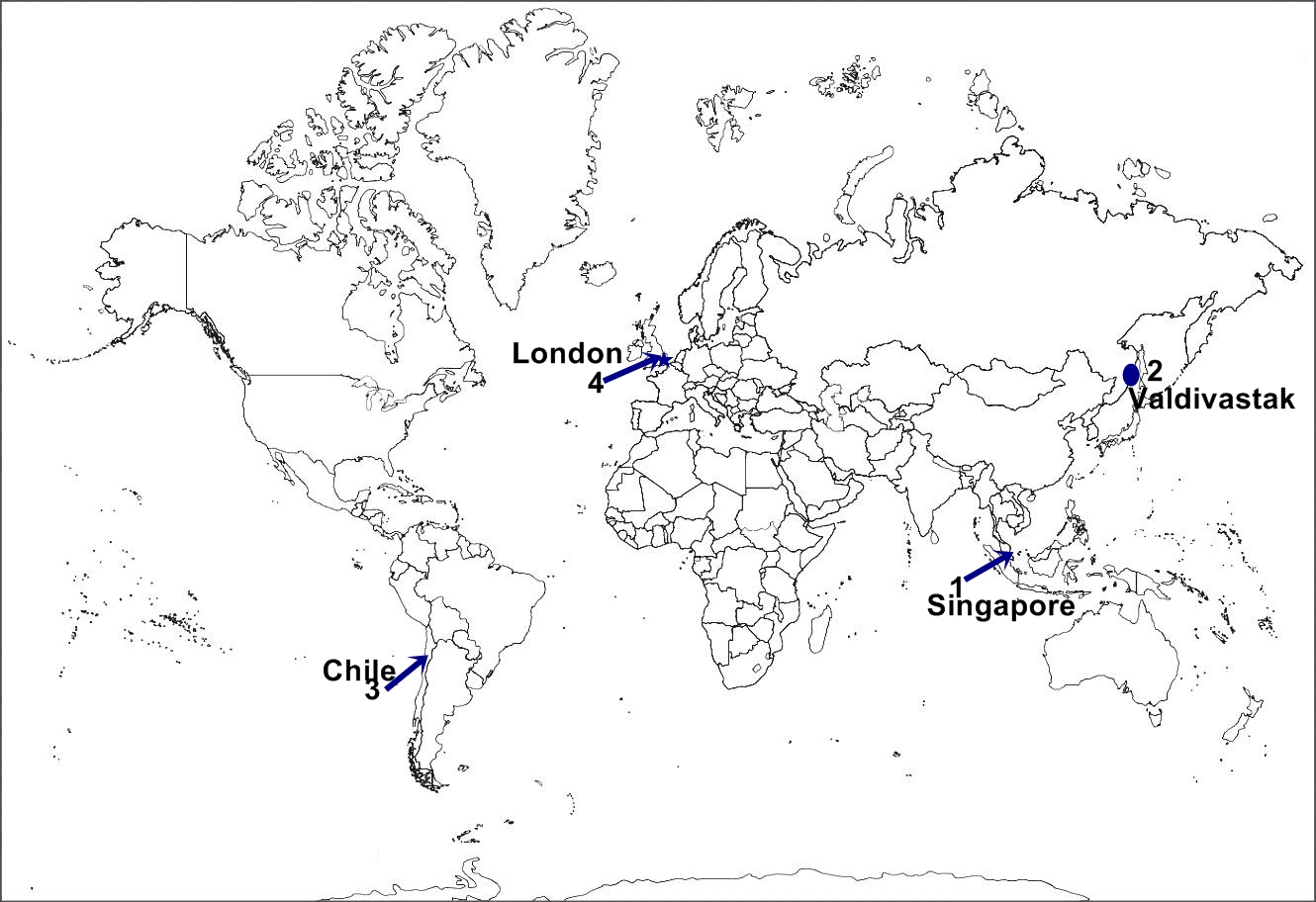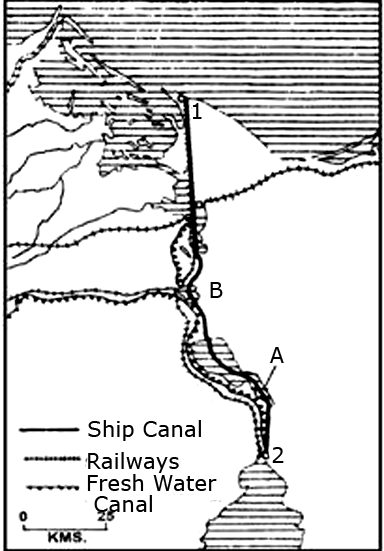Geography: 2004: CBSE: [Delhi]: Set – III
To Access the full content, Please Purchase
-
Q1
On the given outline map of the world are shown four features.
Identify them and write their names on the lines given in the map. 2x1=2 (1) The country having the highest density of population. (2) The eastern terminal of Trans-Siberian Railway. (3) The largest copper producing country and (4) The largest city in Europe . 
On the outline map of India provided, locate and label the following with appropriate symbols: (i) The state having the lowest sex-ratio. (ii) Eastern terminal of East-West corridor and super highway. (iii) The biggest refinery of India . Marks:5View AnswerAnswer:

(1) Singapore (2) Valdivastak (3) Chile (4) London 
(i) Uttar Pradesh (ii) Silchar (iii)
Jamnagar -
Q2
What is the meaning of transhumance? Write four characteristics of pastoral nomadism. 1+2=3 Marks:3View AnswerAnswer:
Transhumance refers to the vertical seasonal livestock movement, especially in higher pastures in summers and in lower valleys in winters. Herders have a permanent home, for eg. in valleys.
Major characteristics of pastoral nomadism are: (i) They depend entirely on natural vegetation. (ii) Nomadic tribes keep on moving in search of water and grass. (iii) It is confined to dry areas. (iv) Cattle fulfil the needs of the local people. (v) Transhumance is practised on the slopes of the hills. -
Q3
Why does intensity of cropping vary from state to state? Explain three reasons with examples. 1+1+1=3 Marks:3View AnswerAnswer:
Intensity of cropping varies from state to state. Several factors are responsible for the variation of crop intensity among the states in India . It can be explained by the following points: Irrigation facilities: If a state has enough amount of water available for irrigation purpose, it will have high intensity cropping. Punjab and Haryana have high intensity of cropping because irrigation facilities are available from the five ever flowing rivers. Use of HYV seeds: The use of HYV seeds is another reason for the variation of crop intensity among the states. The states where HYV seeds are introduced, the crop intensity is high, for eg.it includes states like Punjab and Haryana. Use of chemical fertilizers: The introduction of fertilizers also increases the intensity of crops. The states where farmers are financially satisfied, they can afford to use fertilizers and thus have high intensity of cropping. -
Q4
In which two sections has the subject matter of ‘human geography’ been divided by Finech and Triwarth? State two features of each section. 1+1+1=3 Marks:3View AnswerAnswer:
Finech and Triwarth divided the subject matter of geography in the following two sections: (I) Physical or natural environment (II) Cultural or man-made environment The major features of the two are: (I) Physical environment: The two major features of physical environment are: (i) It consists of physical and natural features and phenomena like climate, drainage, natural resources like soil, water and mineral. (ii) All these elements and phenomena are solely controlled or governed by nature and man. (II) Cultural and man-made environment: Two features of cultural and man-made environment are: (i) It includes man made feature and phenomena on the earth such as population, settlement, as well as features associated with agriculture, manufacturing and transportation. (ii) The development of cultural environment is dependent on technology and skill that man uses to exploit the elements given to him by natural environment. -
Q5
Why is road transport considered more useful than other modes of transport in India ? Explain three reasons. 1+1+1=3 Marks:3View AnswerAnswer:
Road transport is considered more useful in India due to the following reasons: 1. Door to door services: In India, road transport is the only source of transportation which provides door to door service and flexibility of boarding and getting off at any place. 2. Connectivity with villages: In India , it holds the most dominant position because villages of India are connected with cities by roads only. Farmers use bullock carts on kachcha roads to reach cities. 3. Swift hauling for short distance: Most perishable items need rapid movement for short distances, so road transport is very important for swift hauling. -
Q6
What is ‘international trade’? Which are the two types of international trade? 1+1+1=3 Marks:3View AnswerAnswer:
The interchange of goods and services among the countries is called international trade. Two types of international trade are: (i) Bilateral Trade (ii) Multilateral Trade Bilateral Trade: When exchange of commodities and services takes place between two countries, it is called bilateral trade. Primary products are mostly exchanged with manufactured goods between two countries. Multilateral Trade: When goods and services are exchanged among a number of countries, it is called multilateral trade. U.S.A. and Europe are providing technical know how to set up industries to a number of developing countries.
-
Q7
State three ways in which natural resources help humans. 1+1+1=3 Marks:3View AnswerAnswer:
Natural resources are most important for the human beings. The three ways in which they help the human being are as follows: (i) They provide material, energy and favourable conditions for development. (ii) Air, water, land and forests are necessary for man’s survival and development. (iii) Natural resources are renewable and thus in order to conserve non-renewable resources, we can use them. -
Q8
What is rainwater harvesting? State any four objectives of rainwater harvesting. 1+2=3 Marks:3View AnswerAnswer:
Rainwater harvesting is a technology by which groundwater resources are increased and recharged by storing and collecting rainwater in sub surface water reservoirs. Objectives of rainwater harvesting: (i) It helps in meeting the ever increasing demand of water. (ii) It avoids flooding of roads and reduces wastage of water. (iii) It replenishes groundwater and raises the water level and supplements domestic water requirement. (iv) It reduces soil erosion and improves the quality of groundwater by reducing its pollution. -
Q9
Study the data below and answer the questions that follow: 1+1+1=3 Global Land Use Changes (Area in Million Hectares) (From years 1700 to 2000) Broad Land Uses 1700 1850 1920 1950 1980 2000 Forests 6214 5965 5678 5389 5053 3454 Grasslands 6860 6837 6748 6780 6788 3427 Crop lands 265 537 913 1170 1501 1512 8.1 Why has land area under forests and grasslands regularly decreased? 8.2 Why is the crop land area comparatively smaller than those of the other two? 8.3 In which category has the land area undergone the highest decrease in last two decades? How much has it decreased? Marks:3View AnswerAnswer:
8.1 It is because of the population pressure and requirement of land for various purposes. 8.2 This is because man started cultivating late but due to increase in population, the land under cropping has also increased. 8.3 The grassland area has decreased from the last two decades. The area has decreased by 3361 million hectares from 1980 to 2000. -
Q10
Study the map given below and answer the questions that follow: 1+1+1=3

a. Name the two seas connected by the canal shown in the map. b. Name the two ports marked in the map by No. 1 and 2. c. Name the lakes shown by A and B. Marks:3View AnswerAnswer:
a. It connects Mediterranean Sea with Red Sea .
b. No. 1 is Port Said and No. 2 is Port Suez.
c. A is Great Bitter Lake and B is Timsa Lake.



